Home » Other Articles » Going Loco Index » Going Loco - May 2022 - Going Loco - May 2022
Going Loco - May 2022
FRIDAY 27 May
A Right Royal Round Up!

Princess Anne walks past the Super Saloon named after her great grandmother, Queen Mary, during her visit on 27 May 2003 to launch the Special Saloon Car 9002.
Given the fact that today is the anniversary of Princess Anne's visit in 2003, and we are closing in on the Platinum Jubilee of Her Majesty Queen Elizabeth II and our weekend of celebrations at Didcot Railway Centre, there are lots of little royal names throughout the collection. I thought we should go through a Who's Who and a Where's Where of royal connections!
No 1 Bonnie Prince Charlie
0-4-0 Saddle Tank shunting loco, built 1949
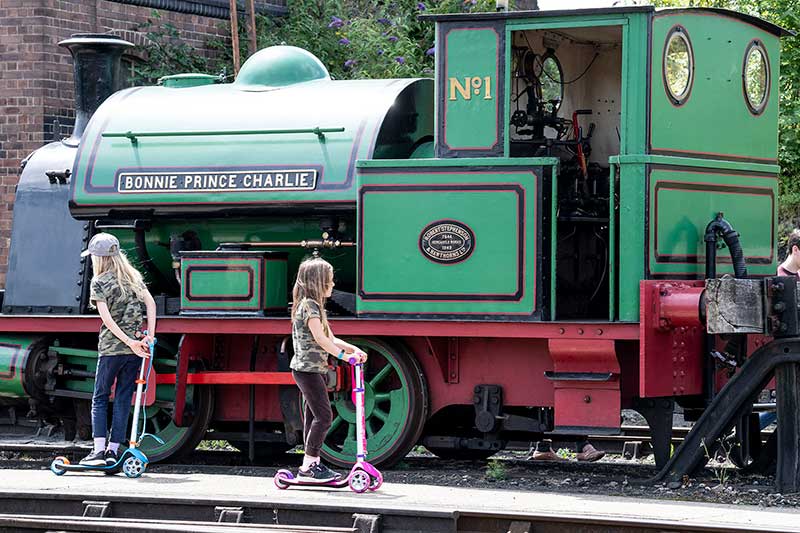
Young admirers in 2020 with the Young Pretender, Bonnie Prince Charlie
Charles Edward Stuart or, as he is known to history, Bonnie Prince Charlie (1720 - 1788). He was a member of the Stuart dynasty of Kings of England and Scotland. He was a major player in the Jacobite rebellion which in 1745 started in Glenfinnan and ended their march into England as far south as Derby. The rebellion was defeated at the battle of Culloden in 1746 causing Charles to flee from Scotland and live out the rest of his days on the continent. His life is now an enduring symbol of the ‘heroic failure’.
No 2409 King George
0-6-0 15” Hunslet industrial locomotive, built 1942
Ok, not sure WHICH King George this is, but it could be:
King George I (born 1660, reigned 1714-1727)
King George II (born 1683, reigned 1727-1760)
King George III (born 1738, reigned 1760-1820)
King George IV (born 1762, reigned 1820-1830)
King George V (born 1865, reigned 1910-1936)
King George VI (born 1895, reigned 1936-1952)
Take your pick...
No 2999 Lady of Legend
4-6-0 Saint class express passenger Locomotive, completed 2019

Lady of Legend during a Timeline Events photo charter on 10 July 2021
This is a bit tenuous but one of the names suggested for No 2999 was Lady Diana after Diana, Princess of Wales (1961-1997).
No 4079 Pendennis Castle
4-6-0 Castle class express passenger locomotive, built 1924

Pendennis Castle on 16 April 2022
Pendennis Castle (the building) was built between 1540-1542 under the orders of King Henry VIII (born 1491, reigned 1509-1547). It is situated near Falmouth in Cornwall. Its purpose was to deter invasion from France and the Holy Roman Empire during the Reformation and was expanded and improved to fend off the Spanish threat towards the end of the century.
It became a Royalist stronghold in the English Civil War and was laid siege by Parliamentary forces in 1646. It survived to be rebuilt by Charles II (born 1630, reigned 1660-1685) after the Restoration of the Monarchy and continued to see service through the Napoleonic conflict and even WWII. It was stood down from military service in 1956 and became property of English Heritage in 1984. It's open to the public so have a ride behind our Castle then visit theirs!
No 5051 Drysllwyn Castle
4-6-0 Castle class express passenger locomotive, built 1936
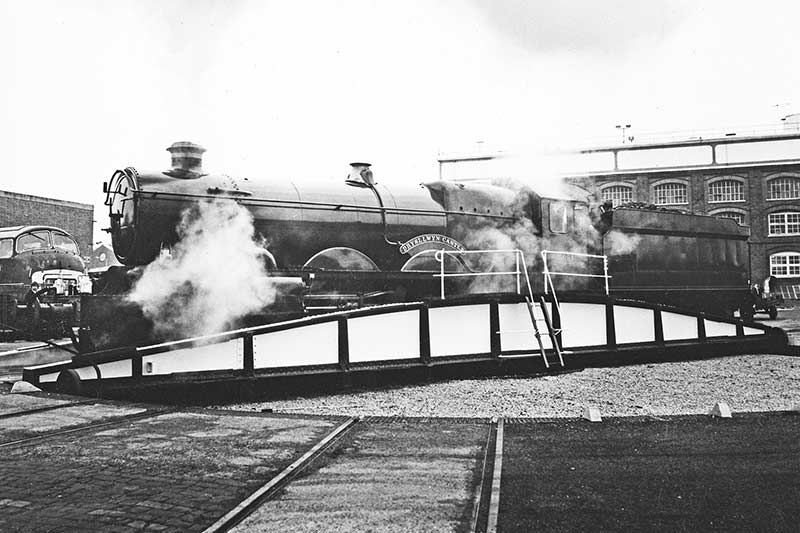
Drysllwyn Castle on the turntable at Swindon Works during a visit to the Weigh House in January 1980
This is a special place in the cultural heritage of Wales. It was built at some time in the 1220s by a prince of the Welsh Kingdom of Deheubarth in response to the English military incursions of the time. Welsh Lord Rhys ap Maredudd (c1250-1292) continued to improve the defences until he turned on the ruling English and the castle was laid siege to in 1287. The forces of King Edward I (born 1239, reigned 1272-1307) captured it after three weeks and following a long series of subsequent engagements, Rhys was captured and executed in 1292.
Another Welsh revolt, this one led by Owain Glyndŵr (c1359-c1415), saw the castle back in Welsh hands in 1403 but the English recaptured it soon afterwards and decommissioned it. The main buildings burnt down not long after and the castle is now a ruin perched high on a rocky hill, halfway between Llandeilo and Carmarthen, overlooking the Towy Valley.
No 6023 King Edward II
4-6-0 King class express passenger locomotive, built 1930
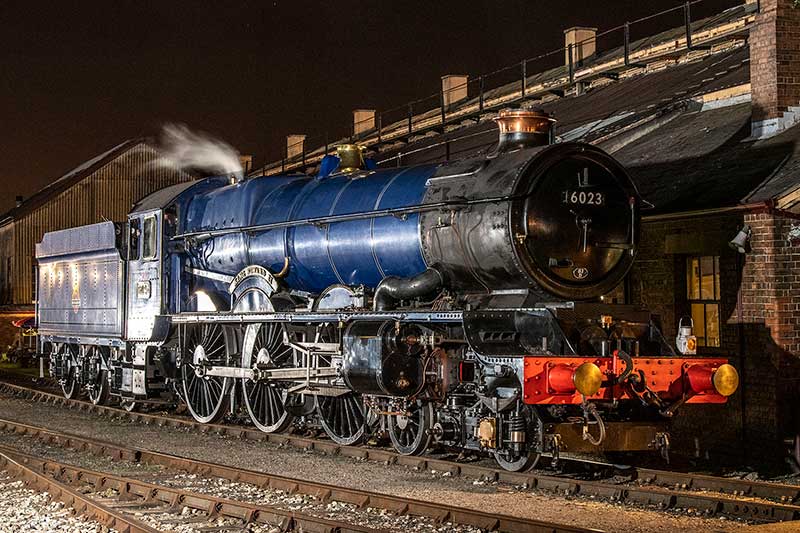
King Edward II during a Timeline Events photo charter on 12 September 2020
An actual specific English royal for this one! However, King Edward II (born 1284, reigned 1307-1327), is not one of our more celebrated monarchs. He is remembered by history for a whole host of poor decisions including but not limited to:
The preferential treatment of his favourite, Piers Gaveston, 1st Earl of Cornwall (1284-1312).
A series of running disagreements with his barons.
Taking the advice of the Machiavellian Despenser family.
A military defeat at the battle of Bannockburn in 1314.
A national famine.
The thorough upsetting of his wife, Isabella of France (c1295-1358 and known as the She-Wolf of France*).
Being generally very unpleasant and being basically incompetent in the role which fate and genetics had lined up for him.
In his favour, King Edward II founded Oriel College, University of Oxford. It is appropriate, therefore, that the locomotive lives in Didcot just down the line from the university city.
Edward II ended up dying in Berkeley Castle (GWR Castle class No 4085) in 1327 due to being probably murdered in a particularly nasty fashion.
Still, the engine itself is an amazing thing to have in the collection...
No 814
Diagram L23 Travelling Post Office coach, built 1940
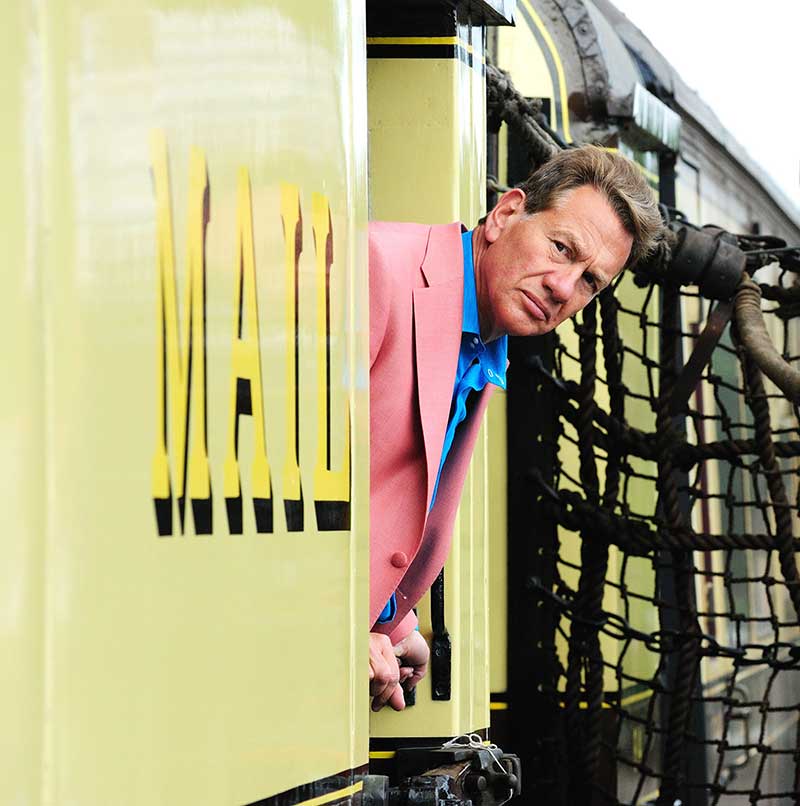
Michael Portillo on TPO coach No. 814 during filming of one of his Great Railway Journeys in May 2011
Well – ROYAL Mail? I might be stretching this a bit but frankly, it spent its working life transporting miniature portraits of monarchs around on envelopes.
I thought it was clever...
No 7372
Hawksworth Brake Composite coach, built 1948
An actual royal connection this time – not just a name. No 7372 was one of the last passenger coaches built by the GWR and was part of the BR Western Region Royal train. As such, its interior remained in pristine condition and was not renovated like so many of its sister vehicles. It is a composite – having first and third class compartments and they have flame maple and quartered oak panelling respectively.
No 9002
Collett Special Saloon, built 1940
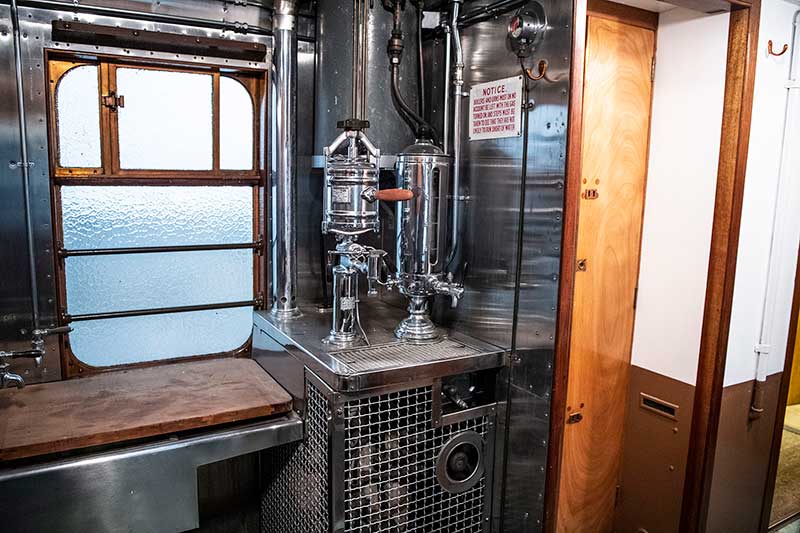
The magnificently restored Special Saloon Car No. 9002 is packed with delights. This is the coffee machine which has produced many a Royal and VIP cuppa since 1940
Like No 7372, No 9002 is an actual royal train vehicle, having served on this and other VIP workings for its whole life. It’s worthy of a Going Loco of its own as it is an amazing piece of craftsmanship both as built originally, refitted at Swindon in 1950 and restored by our fantastic Carriage and Wagon Department.
No 9112 Queen Mary
Collett Super Saloon, built 1932
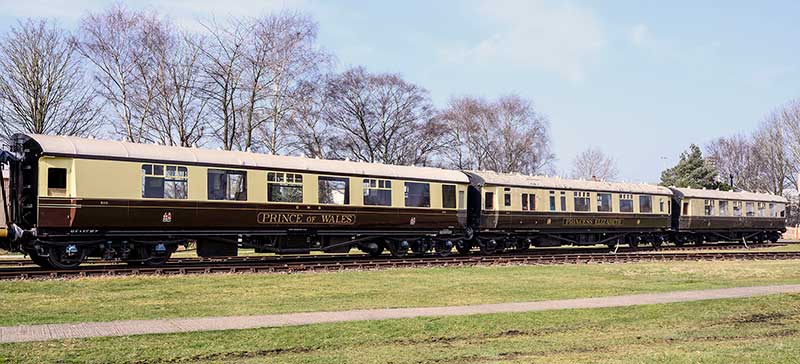
A Royal Flush of Super Saloons, No 9113 Prince of Wales, No 9118 Princess Elizabeth and No 9112 Queen Mary. The opportunity was taken to couple the three together when No 9113 was taken out of the carriage shed to be turned while being lettered in March 2022
We have done a Going Loco on these sumptuously appointed vehicles** so, let's look at the royals! Queen Mary or Mary of Teck (1867-1953) was Queen to King George V (1865-1936). Although she was raised in the UK, the Teck part of her name is due to her family being descended from German nobles. She was due to marry Prince Albert Victor (1864-1892) who was the son of the then Prince of Wales.*** Sadly, he passed away from an influenza pandemic before this could happen. She became engaged to his only surviving brother, George, in 1893.
She was Queen through WWI and supported George V through ill health and political upheaval until his death in 1936. Her son became Edward VIII (1894-1972) who abdicated shortly afterwards, leaving George VI (born 1895, reigned 1936-1952) to reign instead through WWII. She served as Queen Mother to him and the nation and passed away in 1953, seeing her granddaughter, Elizabeth II (b1926) become queen, but not living long enough to see her coronation.
No 9113 Prince of Wales
Collett Super Saloon, built 1932
This is title of the heir apparent in the Royal Family at the time. The Prince of Wales at the time No 9113 was built, became one of the more controversial figures in recent royal history, becoming King Edward VIII. He is remembered as such for two reasons.
Firstly, he is the shortest reigning British monarch due to his abdication, just under a year after his father’s death in 1936. This was due to his desire to marry an American divorcee – Wallis Simpson. Not the done thing for the then Supreme Governor of the Church of England. He was styled as Edward, Duke of Windsor after this point.
The other controversy surrounding him is his touring of Nazi Germany prior to WWII and his relationships with the regime's political elites - including Adolf Hitler (1889 - 1945). This is a complex subject and well outside the scope of Going Loco however... In 1940 he was moved from his home in France to become the Governor of the Bahamas and it is here that he saw out the war. He returned to France at the end of the conflict and finally passed away in 1972, still married to the love of his life.
No 9118 Princess Elizabeth
Collett Super Saloon, built 1932
This is the daughter of King George VI and Queen Elizabeth, The Queen Mother (1900-2002). Yes, that's right the then Princess Elizabeth in the Royal Court of 1932 is none other than our current Queen Elizabeth II! This coach was named after her when she was just six years old. I probably don't need to tell you who Queen Elizabeth II is but she became Queen in 1952 and is still on the throne in 2022.
To say that she has reigned over an incredible period of change and advancement for our nation is an understatement of immense proportions. 70 years on the throne makes her the longest serving British monarch and the longest serving female head of state of all time. It is a truly remarkable record and one that brings this royal round up full circle I think!
*Did the nickname not give it away that upsetting her was a really BAD idea?!
**Luxurious Saloons? Super!, posted on 11 June 2021. Explore this and the rest of the Going Loco Archive
***Later King Edward VII (born 1841, reigned 1901-1910) and Queen Alexandra (1844-1925).
FRIDAY 20 MAY
GWR Steam on the Road?
You know how I said I'd have to get my virtual pen out and write something myself last week? Well...
Photo Frank came up with the fabulous idea about tying into the upcoming Didcot Transport Rally. “Why don't you write something about the fantastic range of Road locomotives that the GWR had?” said Frank. “Great idea”, says I, “except for two minor issues”. “Firstly, I have no reference material about GWR road locomotives and secondly, I know nothing about GWR road locomotives at all...” “Ahhhh” said Frank “leave it with me.” And so I did.
With the Transport Rally this weekend (Sunday 22 May) organised by the Thames Valley and Great Western Omnibus Trust in conjunction with Didcot Railway Centre, we thought it would be an opportunity to look at some GWR road motors, in particular those powered by steam for heavy haulage.
We looked in the GW Trust archive of road motors at Didcot, which contains a massive collection in papers, drawings and photos, thanks to key donations from the late John Cummings and Mr Verner-Jeffreys; the latter was the last head of the GWR Road Motors Department. Note: the GWR always described its road vehicles as Road Motors to distinguish them from Rail Motors.
The first two photos are of a vehicle, U 308, built by the Yorkshire Patent Steam Wagon Co of Leeds about 1905. The novel double-ended transverse-mounted boiler was used to avoid problems on steep hills. With a horizontal boiler mounted fore and aft, skill is required to keep the inner firebox crown covered with water when descending a steep hill.
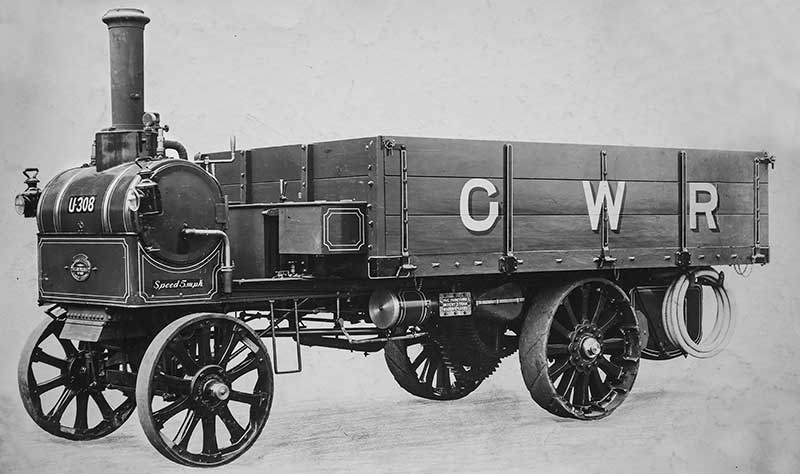
Yorkshire Patent Steam Wagon
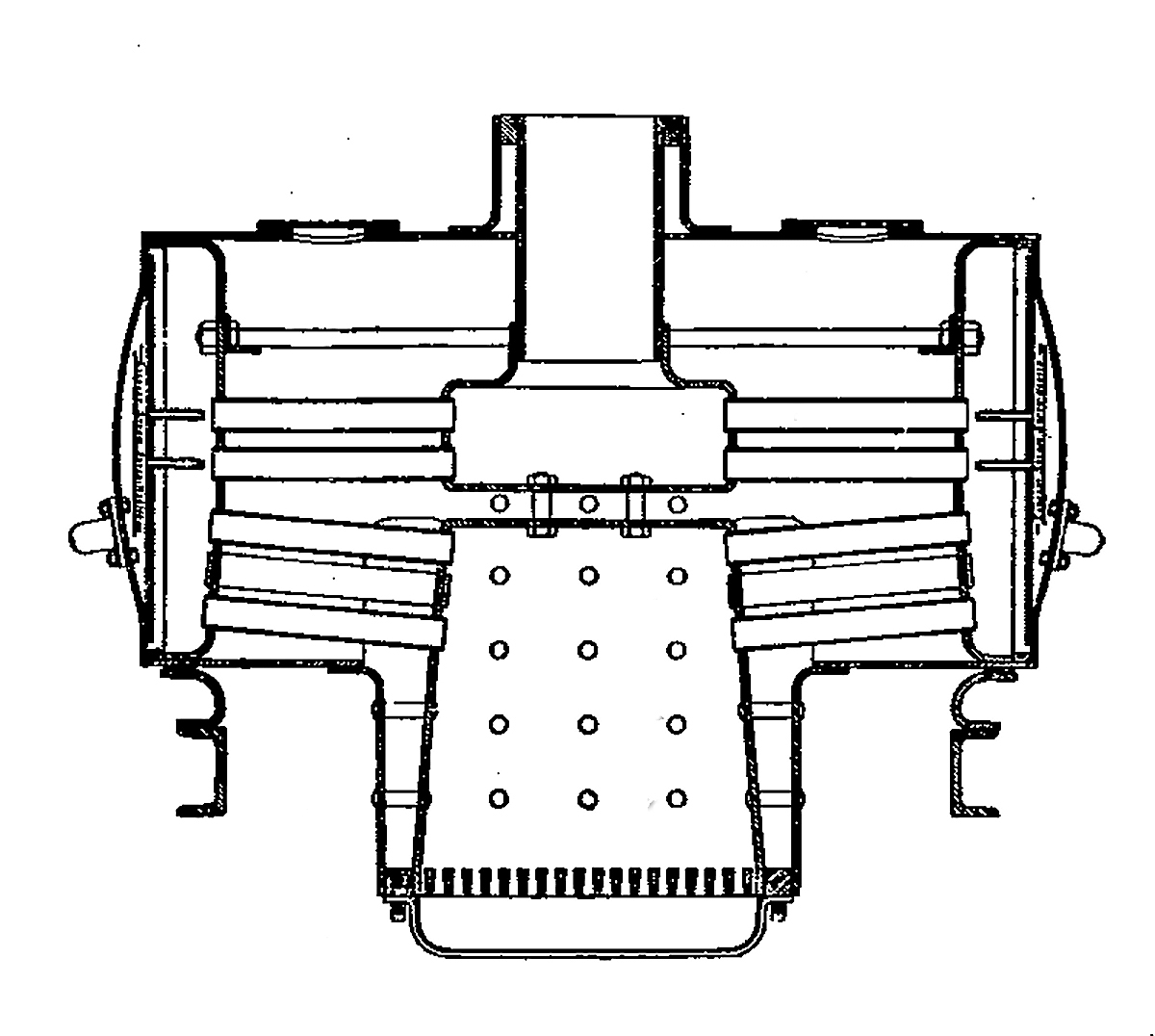
The Diagram of Yorkshire Patent boiler
Yorkshire Patent boiler, mounted side on, internally resembles a Fairlie boiler with a central firebox and multiple fire-tubes to each end. In the Yorkshire though, a second bank of fire-tubes above returns the hot gases to a central smokebox and a single chimney, as shown on this diagram.
The third photo shows the wagon with trailer working at Henwick, near Worcester.

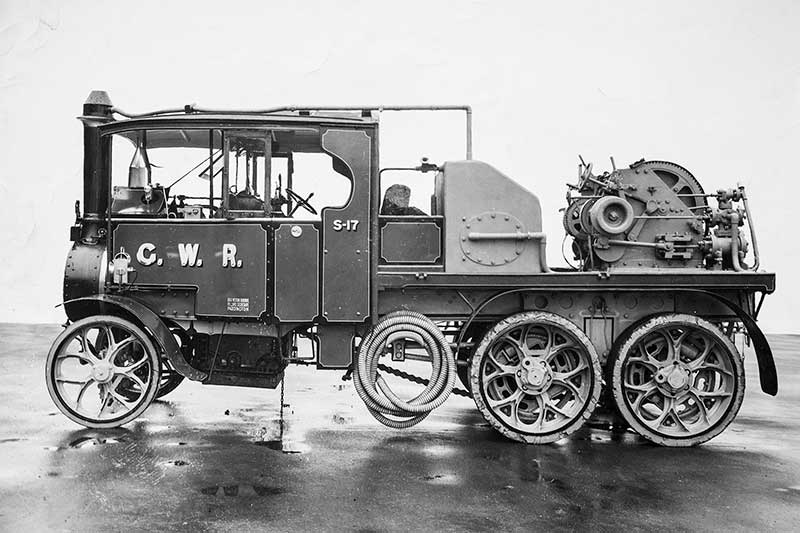
S-17 shown side-on in the photograph was fitted with a winch. The photograph is dated March 1933 and written on the back, rather ominously, is ‘obsolete’.
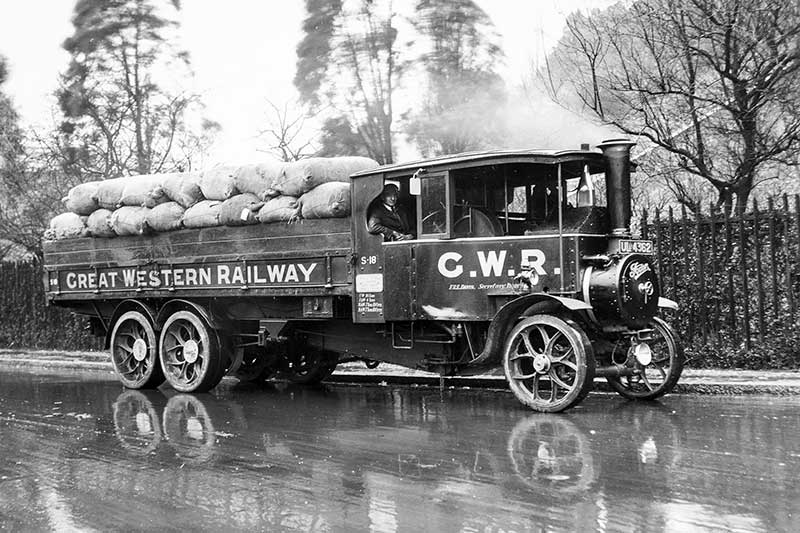
S-18 was fitted with a dropside load bed and is seen here loaded with sacks of grain at Exeter on 6 December 1929. If you are fortunate enough to be a member of the Great Western Society you will already have seen this photo on the back cover of the Echo.
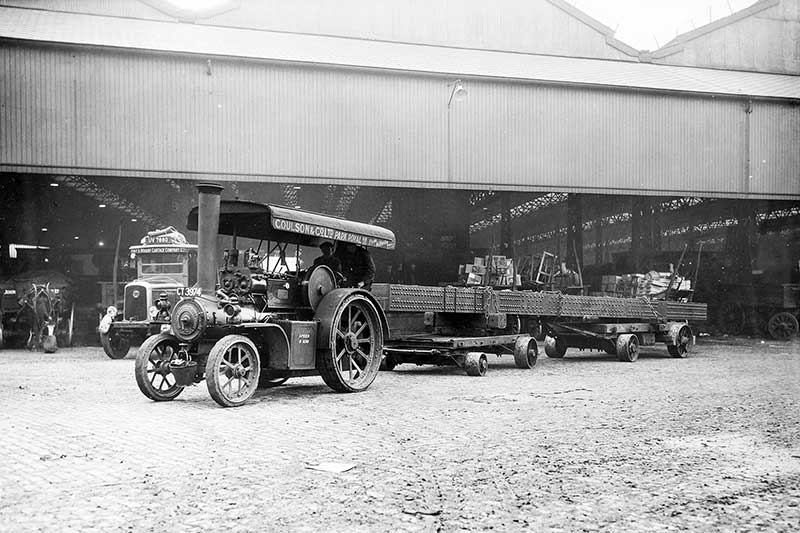
The final photograph is not of a GWR vehicle, but a scene at Paddington Goods depot with a traction engine owned by Coulson & Co Ltd of Park Royal towing a large girder mounted on two primitive four-wheel trailers. The traction engine was built by William Foster & Co of Lincoln.
We hope you all enjoy yourselves at Sunday's Transport Rally.
Thanks Frank! That's an interesting take on Going Loco. It also leads neatly into our Transport Rally at Didcot on Sunday 22 May. We have a whole host of vehicles both cars and commercial vehicles, and other attractions at the park in the Ladygrove Estate. There are a number of extra attractions on at the Railway Centre too.
Which leads me to an interesting thought - perhaps we are now Road Going Loco?
FRIDAY 13 MAY
Blast Sharpeners, Jumper Tops and Illegal Jimmies.
Well, there's a title! Before you stop reading, considering your blogger to have finally taken a dive off the sanity deep end and gone completely barking*, let's take a look into the strange world of draughting. That is the steam flow of exhaust from a steam locomotive. This is a bumper issue with contributions from two great guest writers so grab the beverage of your choice, take to the comfy chair and have a look into some seriously esoteric stuff! This first fascinating section was prepared by our drawing archivist Kevin, so, without further ado, we have our first report ‘From the Drawing Archive’...
The other Thursday was a particularly tough day of drawing scanning for me and 'er indoors. We've reached roll T81 in the grand scheme of re-scanning all the drawings to high res, but four drawings were no more than jigsaw puzzles. They needed best part of a 30 metre roll of archive repair tape and some tense moments, even though the new scanner is designed for delicate drawings.
However, T81 is an interesting roll full of early smokebox blastpipe drawings covering a subject not too many will know about, namely, ‘Blast Sharpening’. Blast Sharpening??… say what?? Well here goes.
GWR locos are well known for their rather loud exhaust when working hard due to the necessity of pulling air up through their narrow deep fireboxes, as opposed to the shallower wider fireboxes of other companies. This ‘working heavier’ exhaust blast dragging air through the fire can have detrimental effects such as jumping the coal all over the place and pulling holes in the fire bed, especially if the fire is too thin, thus letting in too much cooling air. The solution??
Preservation crews on GWR engines will know about ‘Jumper Blastpipe Tops’ (see 46504 below).

As an engine is worked harder, the exhaust ‘blasting’ up the chimney gets stronger and without the jumper top, the increased draw would start to tear the fire apart. Under these circumstances the jumper top lifts, opening the top of the blastpipe to a wider diameter, thus reducing the fierceness of the exhaust blast and hence the draw on the fire. Note, the date of the drawing is May 1912.

5322's smoke box with Jumper Blast Pipe top.
Now, let us rewind to the days before the jumper top, which is what some of the drawings in roll T81 are all about.

Drawings 9901 from 1892 above and 12418 from 1895 below, show a fireman operated version of the blastpipe top. A Handle on the fireman’s side of the cab was pulled or pushed, which operated a rod within the handrail along the side of the boiler, to a crank through the smokebox side, to a pivot that hinged open or closed the blast pipe top.

This blastpipe top is a slightly smaller diameter than the blast pipe itself. It's probably best described as a manual version of the later Jumper Top! When pulled into the closed position, the top flips down, the diameter is smaller thus ‘sharpening’ the exhaust blast and drawing more air through the fire. When working hard, push the handle, the top flips up reducing the exhaust blast.

Drawing 34173 above shows the later 1907 version, now called BLAST SHARPENING GEAR, fitted to Stars, Lots 161, 168 & 173, but also The Great Bear 111 of Lot 171. They were also fitted to a variety of other engine classes, some that would eventually make it into the realm of preservation. But, as far as I'm aware, this manual version was superseded by the later jumper top, certainly by the Collett era, so none of the manual type actually made it into preservation. Have a look at some of the earlier pre-jumper top photos below. Look out for the crank just behind or below the handrail on the smoke box side.

Lot 102 of 1896 Duke class ‘TREVITHICK’ (GW Trust)
Now you know where to look, here's an even earlier photo.

Dean single Lot 84 – 3005 built as a 2-2-2 (later converted to 4-2-2 in 1894). Again, look just above the lubricators on the smoke box side and you can just see the blast sharpening crank. (GW Trust).

Lastly, 2915 Saint Bartholomew, Old Oak Common round house.(GW Trust).
Russell's GWR Locomotives Vol 2 ** has four photos where you can see the blast sharpening gear on the firemen's smoke box side just under the handrail ,… if you have the book, see if you can find them.
Now then, if you spot something on the driver's side of the smokebox in old photos, it's not Blast Sharpening gear. That's Superheater Dampening Gear! Say what (again!) That's probably another article in itself. Once more, something long lost and done away with. As for me and 'er indoors, it's back to Didcot for scanning roll T82, which is the much more mundane ‘Boiler Details’, or if you prefer, butt plates, that join the rolled boiler barrels.
Cheers & stay safe.
Thanks Kevin! We have also had a short reminiscence from another previous friend of Going Loco, footplate man extraordinaire, Mr Ted Abear who has graced us with a few words on his experiences in similar areas too. These are ALWAYS worth listening to. So, with even less ado that the previous sample...
“Most of the locos I worked on had jumper tops on blastpipes. I had heard from the old boys that in the old days if the loco was not steaming well some drivers had a gadget called a "Jimmy"*** that they had made and it screwed across the top of the blast pipe to sharpen the blast. When preparing a loco you (Fireman) checked the smokebox ensuring baffle plates were secure and no blows in steam pipes, also blastpipe jumper top was loose not stuck. The only locos I knew and worked on [with this style fitting] were the 9700 Class Pannier Tank Condensers (or Tunnel Motors as we knew them).”
“We had them on the Smithfield jobs. They had a lever in the corner Fireman's side which was secured by a pin. This was for a baffle plate to drop across the blastpipe when on Underground lines to divert steam in smokebox back into water tank which eventually made water hot hence the water pump fitted on side of the smoke box to put hot water into boiler. I never had the pleasure of using these.
My first trip to Smithfield I was told not to bother trying to use them as they were not used very often and there was the likelihood of the baffle going in and you can't get it back off again. Also the water pump was nor regularly used and might not work, so they were left alone.”
Horses mouth, check! Nice one Ted and thanks to both you and Kevin. I guess I'll have to get my virtual pen out again next week but this has been a pleasure to let others have a drive in this fine old engine we call Going Loco. See you next time!
*Steam engine exhaust note joke - intentional...
** A Pictorial Record of Great Western Engines Volume Two: Churchward, Collett & Hawksworth Locomotives. Here's the cheat,… look at the very first picture in the Preface, just above the driver's head on the smoke box side is a lubricator, look just to the left of it under the handrail. Also on pages 37 (both photos) & page 64, 4-4-0 County.
***Amazingly, one of these devices is preserved in the National Collection. It was presented to photographer Kenneth Leach by Top Link Old Oak Common Driver H. Jermey on his retirement circa 1960. They describe it as follows:
“[An] illegal device for fixing across blast-pipe cone to split the exhaust which makes an engine steam better. Iron square bar with 2 points bent to right-angles with screw adjuster. For Great Western Railway Churchward Jumper top blast pipe.”

We also have this wonderful photo of Driver Harry Jermey on the right with Fireman Jack Rose on the left next to their Castle Class steed, No. 5066 Sir Felix Pole. Jermey earned the nickname 'Rommel' because of the style of goggles he wore when driving!
FRIDAY 6 MAY
Oil Be All Right!
In this age of great uncertainty of supply of coal through various problems ranging from deep international crisis to national government's shortsightedness, the quest for the eco-friendly alternative has certainly intensified. I am personally sure that there will be a solution of this nature in the future, but that we also need to allow the scientists the time to develop and test it. I'll climb down off my soap box... Steam in the past has been powered on a number of alternatives to coal, so let's take a look.

No 3951 Ashwicke Hall after conversion to an oil burner in April 1947.
The very early steam engines were powered by coke. This is a fuel produced by roasting or heating coal in an oxygen free environment. The idea here is that it gets rid of many of the impurities associated with burning coal. The reason for its use back in the dim and distant past of the railways was that it was effectively a smokeless fuel. A very early piece of environmental legislation demanded that steam locomotives ‘consume their own smoke’. This only really became possible much later on with the introduction of the brick arch. The arch makes the hot gases and combustible stuff in them travel much further than straight up and out, giving it more time to burn. This enabled the lower grades of coal to be burnt but didn't preclude the smoke from a poorly performing or poorly fired locomotive!

A Swindon drawing from the GWS archive of brickwork modifications to the firebox of a 28XX class steam locomotive.
Wood – in use today as a modern renewable fuel in several forms – was also common in certain parts of the world. The early railways of the United States saw a lot of wood burning steam engines. They have great forests on that continent so it was one of those ‘no brainer’ type decisions to try it. Whilst it works – you CAN fire engines on wood – it has a massive drawback. It's the amount of energy you can get out of it. The wood they were using could release around 3,200 British Thermal Units (BTU) per pound, but even average coal can give off 10 - 14,000 BTU per pound.

Refuelling oil burning 2-8-0 No 4801.
You had to REALLY stack that tender to go the same distance as your coal burning brethren. Lots of other variations on this theme have been tried successfully. They are usually waste products from an industrial process. The most famous being the little steam engines used in the production of sugar beet. The fine particulates of this fuel can be still alight as they exit the chimney, giving a real fireworks type show. Not a great idea in dry brush though it has to be said.
When the GWR emerged from the dark days of the Second World War, it did so with renewed optimism. It was not in the best state financially but there were other railways FAR worse off than them. They began to look forward. For the medium and long term they started to look at new forms of traction. The gas turbine locomotives Nos 18000 and 18100* were ordered and much talk was given to electrification in other areas. In the short term, their dependence on coal came under scrutiny.

The reason for this was simple – economics. Before the war the fuel needs for the GWR were met by the superior South Wales steam coal. This is an energy rich fuel, with around 14,000 BTU per pound. During and after the war, access to this fuel became harder and harder. The government had restricted access to it and labelled it for export only. This left the engines to consume coal of an inferior quality. This put the fuel consumption up. If you then make this fuel more expensive, things get tricky. In 1939, average coal consumption and cost was 44.21 pounds at 4.44d (1.85p) per mile. In 1944 this went to 55.18 pounds at 11.88d (4.95p) per mile. Then, in 1947, one of the worst winters our nation has suffered in recent history hit. A coal crisis had ensued.

The oil fuelling depot at Swindon.
The GWR consulted with the Anglo-Iranian Oil Company and Swindon converted several locomotives from coal to oil burning from 1945. Oil is even more energy rich than best steam coal – 18,000 BTU per pound. They started with 28XX class 2-8-0 freight locomotives but eventually expanded to Hall and Castle class 4-6-0s and a single 2-6-0.
The oil was a heavy fuel oil and was really thick. It needed heating with steam pipes inside the tank to get it to flow easily. Handy that there were all these steam engines around when you think about it... Putting it on board the engines was relatively easy, the coal space of the tender had a tank fitted to it. The firebox of the engine however was a bit different. The lower firebox was lined with refractory brick. The same stuff that is in storage heaters and that we make the brick arch from in our coal burners. The oil burners then went inside. The fire hole door was different in that it wasn't regularly opened and so just had an inspection hole flap.

Oil firing was a great boom to the crews. No more shovelling tons of coal for a start! It also meant that the fire hole door was not being constantly opened and closed. This going from pitch black to blazing fire and back had a marked effect on the crew's night vision. Not good when you are looking for signals – something the fireman could now do far more of so there was a theoretical gain in safety margins too. Ash wasn't produced and neither was clinker. This meant the fire was at the same efficiency at the beginning and the end of the day. Also, imagine the joys of those crews upon returning to shed – no emptying the ash pan out at the end of the day!

The fireman at the controls of an oil-fired locomotive. This drawing was in Next Station, a book published by the GWR in 1947 to describe its plans for the future.
Speaking of ash, the amount of dust produced and floating around went way down. The footplate became a much cleaner place, coal dust from the tender was a thing of the past. Most noticeable when tender engines went backwards. Not a pleasant experience with dusty coal... The controllability of this system of heating water was far easier. Putting coal in a firebox and getting it to burn at the right temperature at the right time is a genuine art but oil firing was endlessly and instantly controllable and heat was there on demand. It actually made it more difficult to excuse lifting the safety valves and wasting water through them so there may have been an economy there too.
There was so much interest in the scheme that the government funded the conversion of 1,200 locomotives on all railway companies to help offset the coal shortages. A technically excellent solution, which made working lives better and had the backing of the government. So why are there no preserved GWR oil burners? The programme had got to a total of 93 engines across the UK and 36 of them were GWR machines. In 1948, the railways had been nationalised and this formed the nascent British Railways. When they looked at it from a governmental funding perspective, the penny dropped. Where were they going to get the finance to pay for all this fuel?

A diagram from Oil-Fired Steam Locomotives, a handbook for enginemen published by the GWR at Swindon in May 1947.
A post WWII UK wasn't in the best health financially so it isn't surprising that the oil burners were returned to coal firing in just 9 months. The UK to this day still has vast reserves of coal. It's one of the major factors in us becoming the seat of the industrial revolution and with the scarcity of foreign exchange for a fuel we couldn't produce ourselves, oil firing just wasn't on the cards. So is there nothing left of this bold experiment? Not quite. If you look opposite our preserved lifting shop at Didcot, you will see two single storey flat-roofed grey brick buildings and some saddle-shaped constructions. These are the remains of fuel oil storage tanks and pump houses that were being built at Didcot before the programme was cancelled. I have to say that I have personal thanks for this as one of the buildings is used as a mess room and hot tea served in there over the winter months has kept many a locomotive restorer on track.
Pun intended.
So there!
*There's a blog for that! Look at ‘The Turbine Twins’, August 2021.
 |
 |
 |
 |
Didcot Railway Centre Newsletter
Stay up to date with events and what's going on at Didcot Railway Centre.
You may unsubscribe at any time. We do not share your data with 3rd parties.